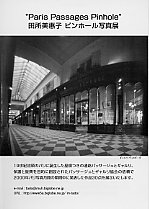The covered Parisian passages were born between
the end of 18th century and the mid of 19th century, a little bit before
and after the birth of the Photography. Recording such places in photographs
could be realized only after a progress of the plate with sufficient sensibility.
In the pictures of these passages left by the photographers of the 20th
century, among others by Atget, therefore, we cannot mark any more the
prosperity of gathering and shopping places in old days.
Because, instead of passages, the department
stores offering larger variety of goods had already appeared in the beginning
of 19th century and the boulevards had been developped, the narow and dark
passages attracted less people.
These passages loosing commercial interests
have been deserted for a long time and utilized no more than warehouses
or shortcuts. Past few years, however, thanks to the renewal of the places
and the arrival of new stores on the initiative of the "Association
Passages et Galeries" they have come to find their original beuty.
But people who visit there now seek no more fashionable gatherings in these
places and they are there in search of the good old days and for an instant
breath between the disturbing outside streets.
Today, I would like to capture patiently
in an image not only the accumulated times but also the time running slowly
there by the help of a tiny hole, which needs a very long exposure time*.
Because the pinhole photography seems to me an appropriate means for those
who want to be free from the everyday life in which convenience and speed
are the key words.
*(from few minutes to half an hour)
Mieko
TADOKORO
| Paris Passage Pinhole |
 |
| November 16 to 30, 2002 |
| Maison Franco-Japonaise, Tokyo (Ebisu) |
| |


